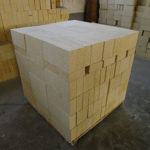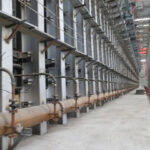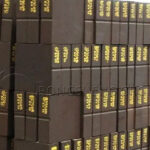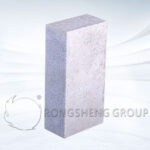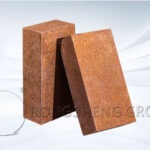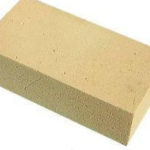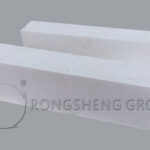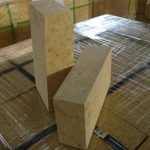At present, silicon carbide mullite bricks are widely used in domestic large and medium-sized cement rotary kilns as the preferred refractory material for the non-fired zone. However, silicon carbide mullite bricks use the corundum phase as the main phase and natural bauxite clinker with high aluminum content as the main raw material. And the addition of more silicon carbide leads to a large thermal conductivity. The surface temperature of the rotary kiln is high, and the heat loss is large, which increases the heat consumption of clinker firing, and the use effect is not ideal.
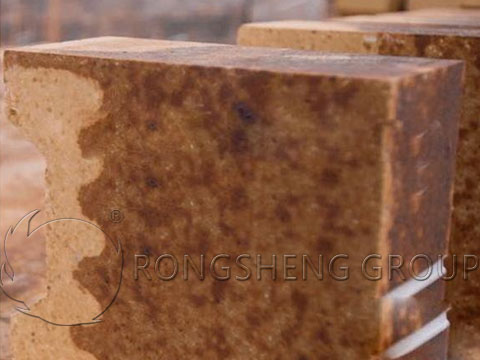
Rongsheng refractory material manufacturer recommends low thermal conductivity multi-layer composite mullite bricks for customers according to the customer’s demand for reducing heat loss and adopts the multi-layer composite structure design of working layer, thermal insulation layer, and thermal insulation layer. The low thermal conductivity multi-layer composite mullite brick uses bauxite-based sintered mullite to replace the natural bauxite clinker used in traditional silica mullite bricks as the main raw material. With mullite as the main phase, the overall thermal conductivity of mullite bricks is reduced, and the high-temperature structural strength is effectively improved.
Based on the poor erosion resistance of mullite slag, the matrix was optimized by adding some composite additives and increasing the alumina content of the matrix, which improved the alkali erosion resistance of refractory bricks. In order to further reduce the thermal conductivity of the working layer of the product, 97# silicon carbide fine powder with better crystal development is used, and andalusite fine powder is added to strengthen the matrix. It not only reduces the thermal conductivity but also improves the high-temperature structural strength and thermal shock resistance of the refractory brick.
Specifically, the design of each layer of refractory material and its corresponding performance index are as follows.
(1) Working layer. M70 bauxite-based sintered mullite is used as the main raw material, and homogenized bauxite is used as the aggregate and powder. Andalusite, silicon carbide, and other multi-component additives are added to achieve the purpose of extending the service life. The performance indicators of the working layer are Al2O3≥67%, apparent porosity≤20%, and bulk density 2.70 g/cm3. The cold-pressed strength is 90~100 MPa, and the softening temperature under load is more than 1650 ℃. Thermal shock stability (1100 ℃ water cooling) ≥ 30 times, comprehensive thermal conductivity ≤ 1.65 W/(m·K).
(2) Insulation layer. The mullite phase is mainly used, M60 bauxite-based sintered mullite is used as the main raw material, and some composite additives are added to adjust the expansion coefficient. Make it close to the working layer to avoid cracks from the joint during sintering or use. On the premise of meeting the strength, the thermal insulation effect is improved.
(3) Insulation layer. Thermal conductivity is an index to measure the thermal conductivity of materials, and the thermal conductivity of different materials varies greatly. By adding substances with low composite thermal conductivity to the thermal insulation layer, the comprehensive thermal conductivity is reduced. On the premise of satisfying the strength, the thermal insulation effect of the refractory brick is improved.
In the area where multi-layer composite mullite bricks are used on the rotary kiln, the temperature of the cylinder can be reduced by 50~80℃. The average temperature of the transition zone in front of the rotary kiln is 250℃, and the thermal insulation effect is obvious. It is especially suitable for the front transition zone of large and medium-sized cement rotary kilns. The service life is not less than that of spinel brick, SIC mullite brick, or SIC mullite red brick. In addition to being used in the transition zone in front of the rotary kiln, it can also be used in the tertiary air duct, the side wall of the grate cooler, etc., and it will also achieve satisfactory results.
RS Refractory Bricks Manufacturer
As a refractory brick manufacturer and sales manufacturer, RS Refractory Bricks Manufacturer has rich experience in production and sales. It also has its own unique solutions for dealing with the refractory materials lining various kilns and has solved many difficult problems for customers successively. To purchase refractory bricks, refractory castables, thermal insulation bricks, thermal insulation castables, etc. for cement rotary kiln, please contact us. Based on your specific needs, we will provide you with the best refractory brick products for your rotary kiln production needs.

